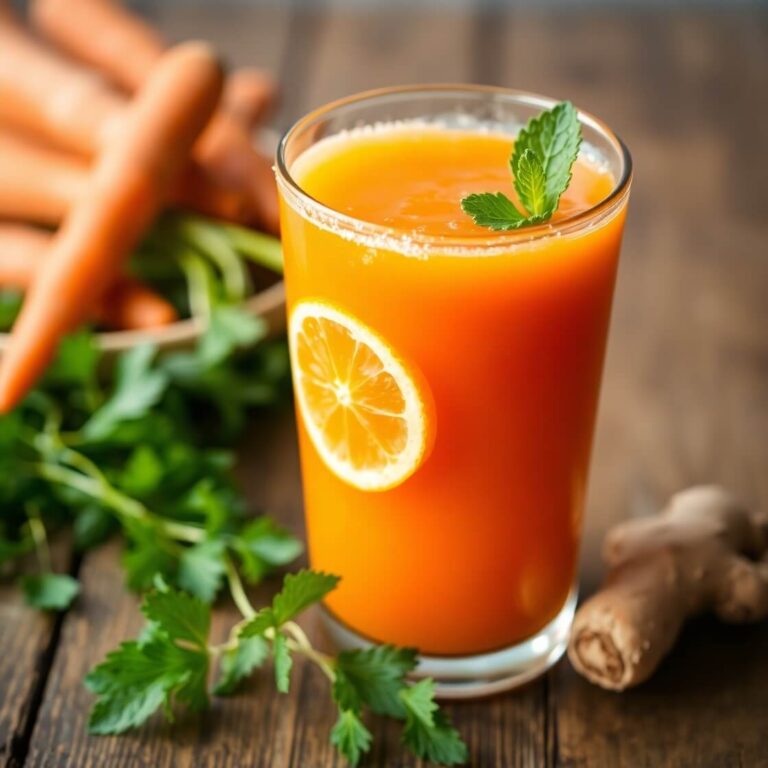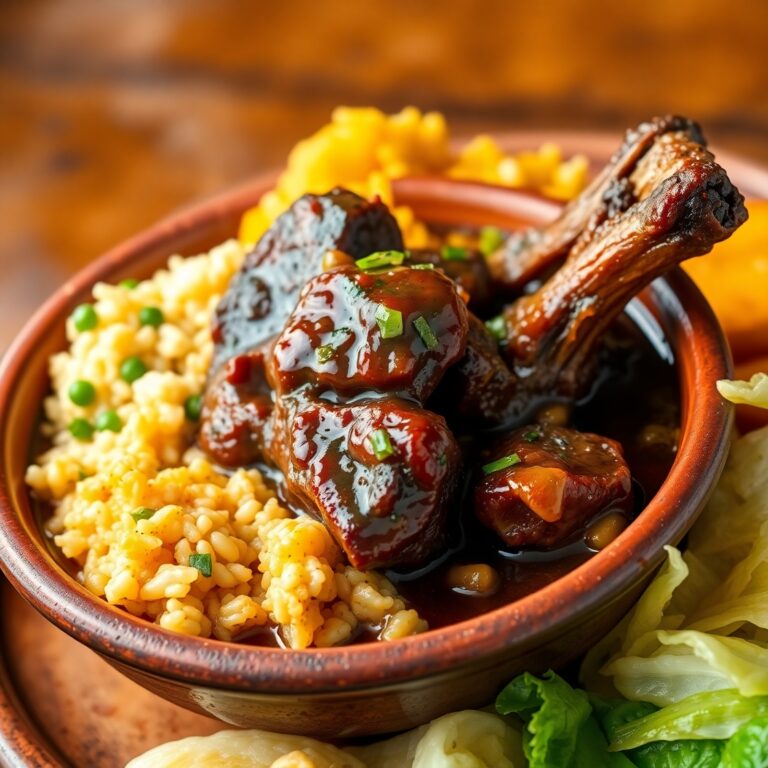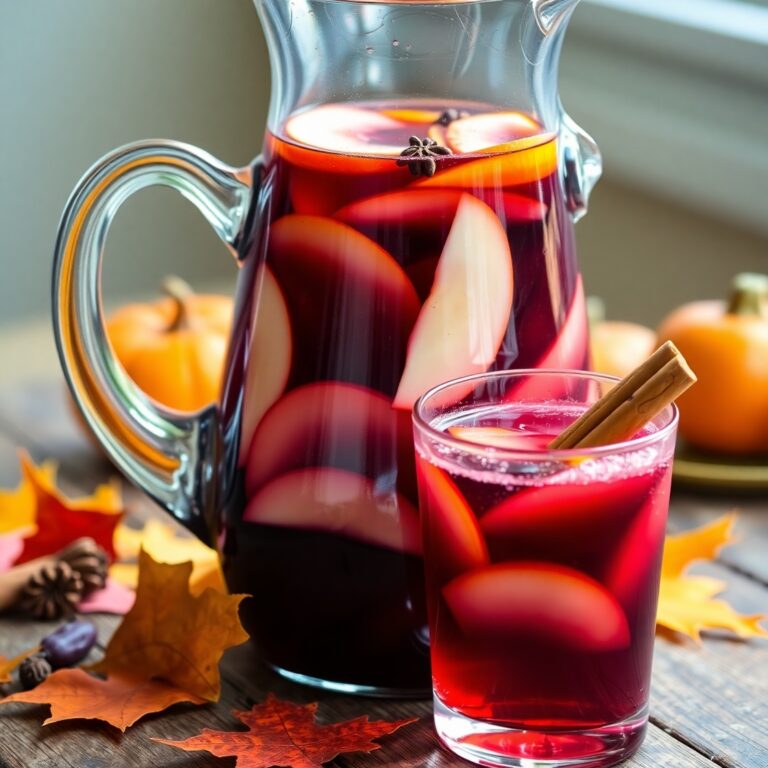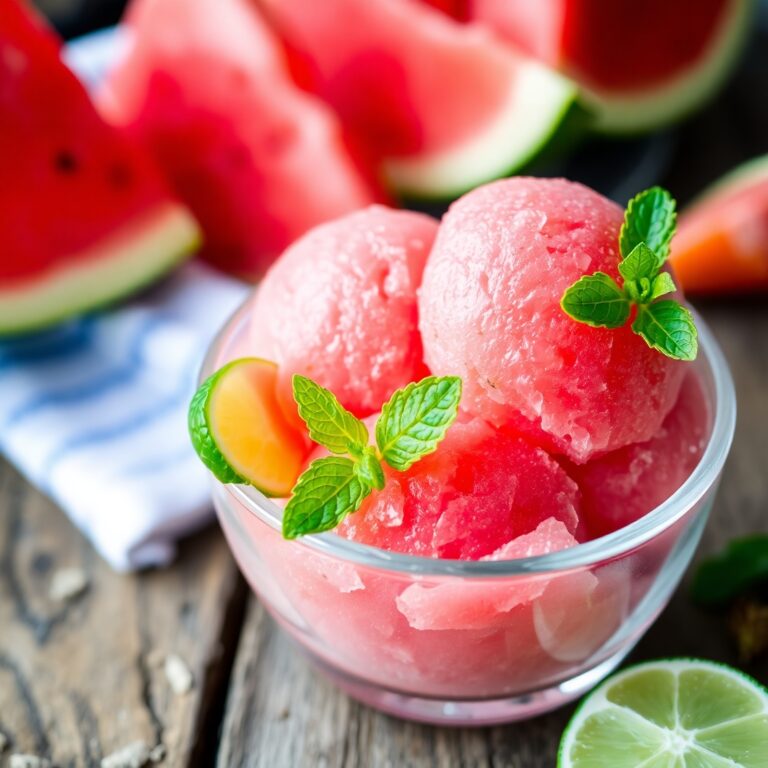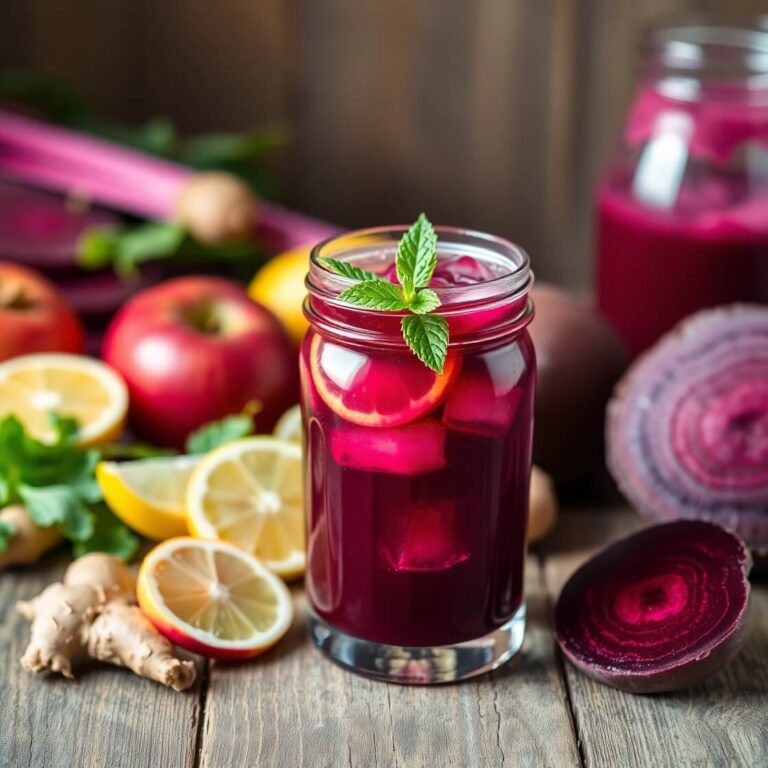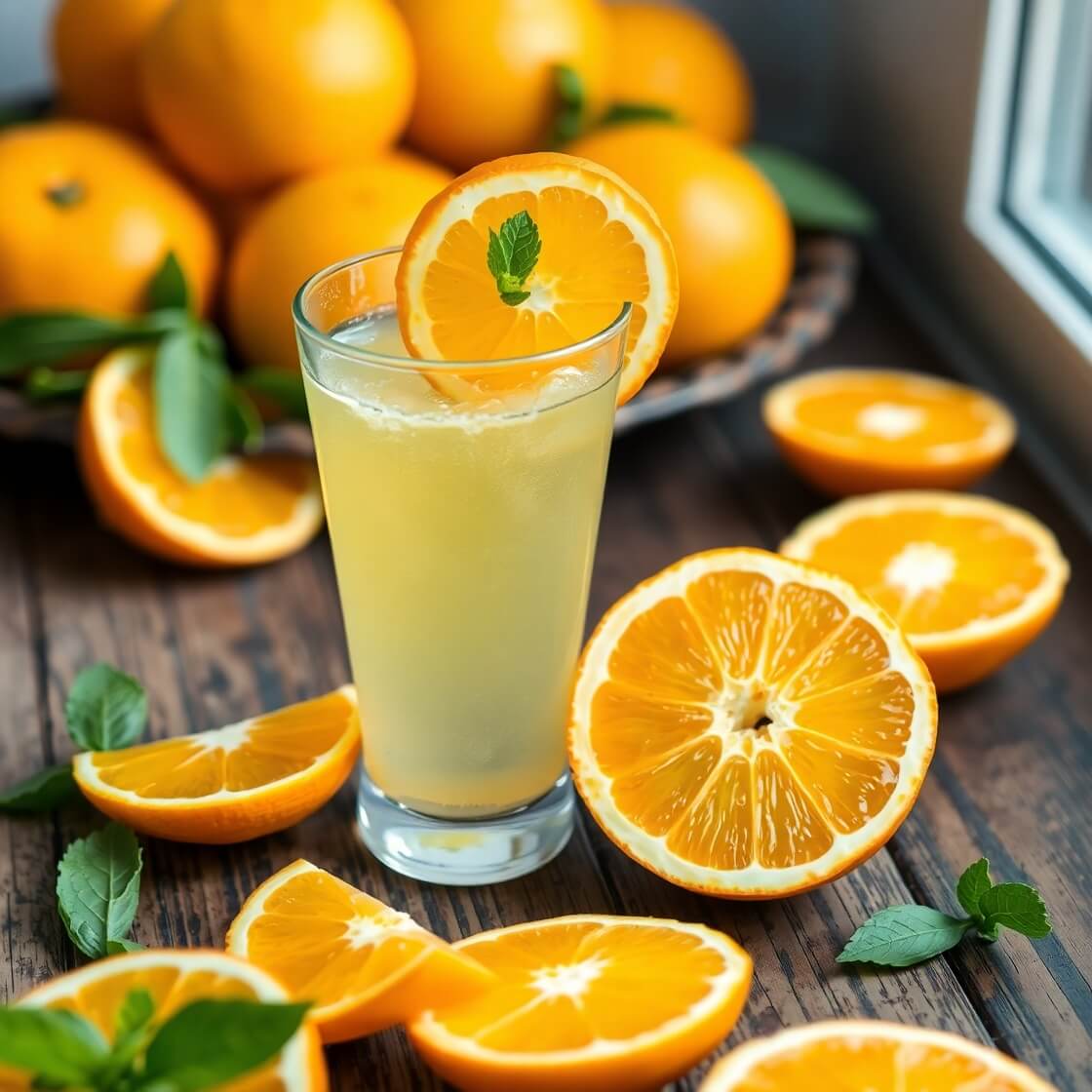
Freshly squeezed orange juice is more than just a morning ritual—it’s a moment of sunshine in a glass.
I created this recipe during one of those long, humid summer days when water just wasn’t enough. I had a basket full of plump, juicy oranges and a deep craving for something cold, tangy, and rejuvenating. Rather than buying store-bought juice loaded with additives, I decided to make my own. The result? A glass of natural, zesty, refreshing juice that made me want to keep experimenting with different styles and flavor twists.
This orange juice recipe guide is crafted for anyone who’s tired of the artificial flavor of packaged juices and is ready to embrace the natural sweetness of real fruit. Whether you want a simple, pure orange juice or something with a hint of ginger or mint, this guide walks you through every step with clarity and care.
Read on to learn how to extract the bold, sweet, and citrusy essence of oranges—and make it a regular part of your day.
Why I Love This Recipe
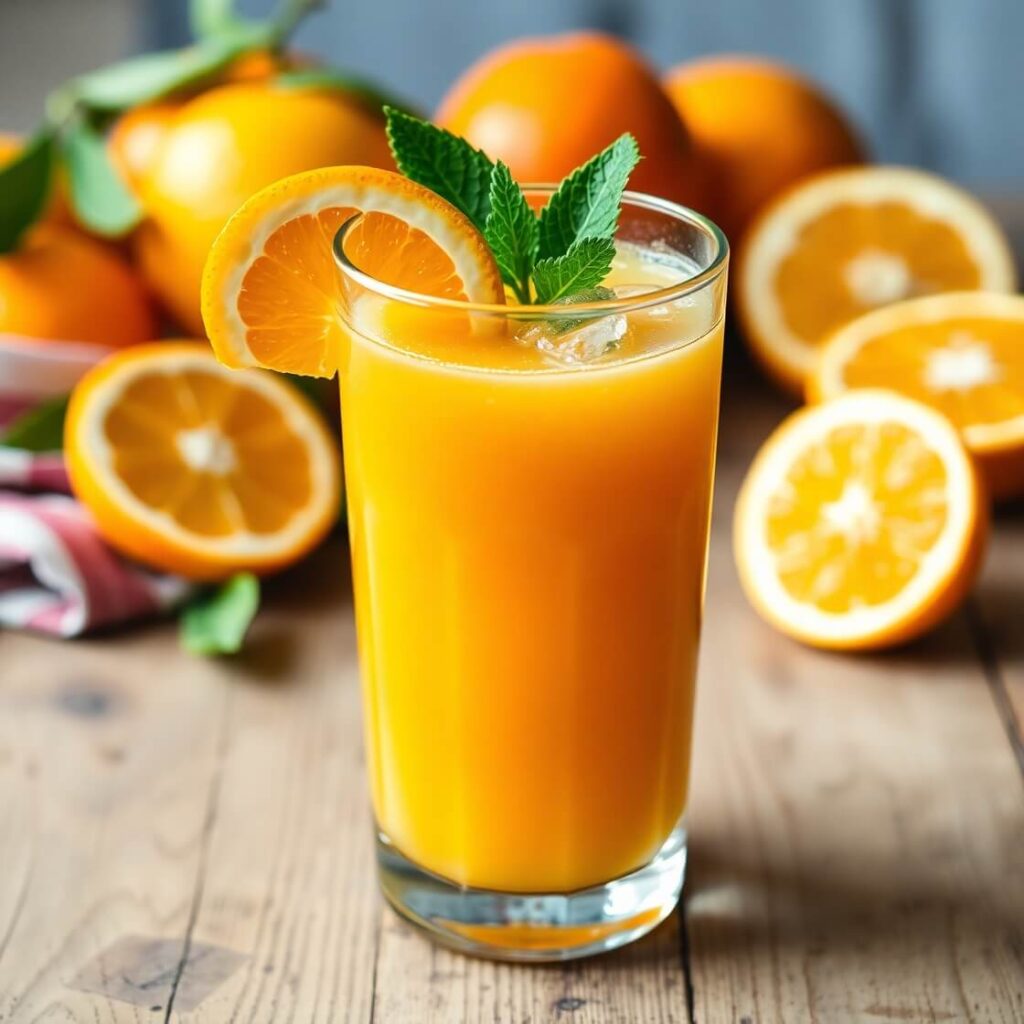
There’s a reason why orange juice is a staple in so many homes.
It’s not just the vibrant color or the sweet aroma that fills your kitchen when you slice into a ripe orange—it’s the simplicity of making something so pure, so nutrient-rich, and so satisfying. With just one ingredient and a little technique, you can transform whole fruit into a beverage that feels luxurious and nourishing at the same time.
I love this recipe because it’s versatile. You can make it rustic and pulpy, or smooth and refined. You can drink it as-is, use it in smoothies, or as a mixer in mocktails and cocktails. It’s a great recipe to have up your sleeve because it’s both beginner-friendly and endlessly customizable.
Another reason I keep returning to this recipe? It gives you complete control over what you’re drinking. No preservatives. No added sugar (unless you choose to sweeten it). Just fresh, whole fruit—and the joy that comes from making something yourself.
Ingredients for Orange Juice
To make a refreshing batch of orange juice, you only need a few ingredients—but quality is key.
Essential Ingredients:
- Fresh oranges – Choose sweet, juicy oranges like Valencia, Navel, or Cara Cara. You’ll need about 4–6 medium oranges for 1 cup of juice, depending on their size and juiciness.
Optional Add-ins:
- Lemon juice – A splash helps brighten the flavor if your oranges are overly sweet.
- Mint leaves – For a cooling, herbaceous undertone.
- Fresh ginger – Adds a little zing and warmth, great for immunity.
- Honey or maple syrup – Only if needed, and just a teaspoon at a time.
- Cold water or ice – To dilute for a lighter juice.
Always use ripe, firm oranges with smooth skin and a slight give when you squeeze them. The fresher the fruit, the better the flavor.
How Much Time Will You Need?
Making orange juice is surprisingly quick and straightforward.
- Preparation Time: 10 minutes
- Juicing Time: 5 minutes
- Total Time: 15 minutes
If you’re making a larger batch or adding variations, budget about 20 minutes. Cleanup is minimal, especially if you’re using a hand press or manual citrus juicer.
How to Make This Orange Juice Recipe

Here’s a detailed, step-by-step guide to making the perfect glass of homemade orange juice.
Step – 1: Wash and Dry the Oranges
Start by rinsing your oranges thoroughly under cold water to remove any residue or wax. Pat dry with a clean towel.
If you plan to use the zest later (for garnishing or flavoring), it’s especially important to clean the skin well.
Step – 2: Roll the Oranges
Before slicing, gently roll each orange on your countertop using the palm of your hand. This helps to loosen the juice and makes extraction easier.
Step – 3: Cut the Oranges
Using a sharp knife, slice each orange in half crosswise. If you’re using a manual citrus press, make sure the cut surface is flat for optimal pressure.
Step – 4: Juice the Oranges
Use your chosen juicing method:
- Manual Citrus Juicer: Place the orange half cut side down and press firmly to extract juice. Twist slightly for maximum yield.
- Electric Juicer: Hold each half against the reamer and press gently. The machine will do the work.
- Hand-Squeeze (Last Resort): Hold the orange in your hand and squeeze over a bowl, using a fork to help release juice.
Strain the juice through a fine mesh sieve if you prefer it pulp-free.
Step – 5: Add Flavor Enhancers (Optional)
Now’s the time to personalize:
- A splash of lemon juice for brightness
- Grated ginger or mint for depth
- A touch of honey if it’s too tart
Stir well to combine.
Step – 6: Serve Cold
Pour into a chilled glass over ice or store in the fridge until ready to serve.
Fresh juice is best consumed within a few hours to retain its nutrients and flavor.
Substitutions
Homemade orange juice is flexible—here are a few substitutions to suit your preferences or what you have on hand:
- No fresh oranges? Use cold-pressed bottled orange juice as a base and enhance it with lemon or ginger for freshness.
- Prefer low-acid? Swap half the oranges with mandarins or tangerines for a sweeter flavor profile.
- No juicer? A blender works well—just peel the oranges, remove seeds, blend until smooth, and strain the juice.
- Want fiber-rich juice? Skip straining and enjoy it with the pulp for added fiber.
- Looking for extra zing? Add grapefruit or blood orange juice for a more complex citrus taste.
These options allow you to tailor the juice to your diet, taste, and equipment.
Best Side Dishes for Orange Juice
Orange juice pairs beautifully with both sweet and savory dishes. Here are three side dishes that elevate your juice experience:
- Buttery Croissants or Almond Danish – The flaky, rich texture balances the acidity of orange juice.
- Greek Yogurt with Berries and Granola – Creamy, tangy, and full of texture, it makes for a complete and satisfying breakfast.
- Avocado Toast with Chili Flakes – The smoothness of avocado pairs well with the citrusy brightness, especially with a spicy kick.
Serving and Presentation Tips
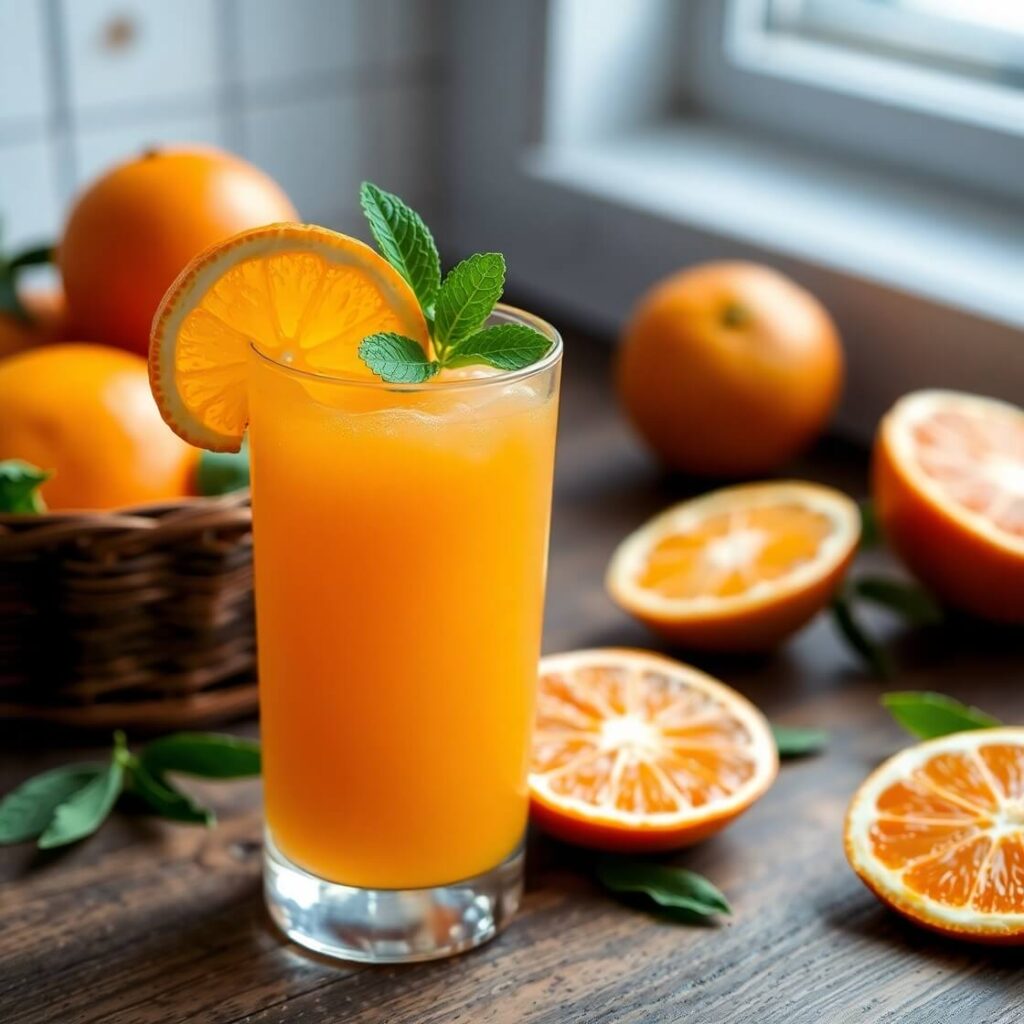
The way you serve your orange juice matters more than most people realize.
A chilled, sparkling-clear glass enhances not only the appearance but also the sensory experience. Here’s how to elevate the presentation:
- Use a tall, transparent glass to showcase the vibrant orange color.
- Garnish with a thin orange wheel on the rim or float a twist of orange peel on top for a touch of elegance.
- Add a sprig of fresh mint or a few frozen berries for contrast in color and flavor.
- If serving during brunch or a gathering, use a glass pitcher and place it on a tray with sliced citrus and ice for a beautiful table setting.
Presentation turns even the simplest juice into something guests admire and remember.
Tips and Tricks to Make This Recipe Even Better
Want to make your orange juice stand out every single time? Here are my top secrets:
- Chill your oranges before juicing. Cold fruit not only juices better but also makes the final product instantly refreshing—no need for extra ice.
- Add orange zest. Before cutting the oranges, zest a bit of the peel and stir into your juice. It intensifies the aroma and deepens the citrus flavor.
- Blend with other fruits. Mix in pineapple, mango, or even strawberries for an exotic twist while keeping the base citrusy and bright.
- Strain for a smooth texture. Even if you love pulp, straining it gives a professional, silky result.
- Balance flavor with a pinch of salt. Just the smallest pinch enhances the sweetness and balances acidity.
Mastering these tricks helps you create a better-than-store-bought juice every time.
Common Mistakes to Avoid
Making orange juice seems foolproof, but a few missteps can affect flavor or freshness. Avoid these common pitfalls:
- Using underripe or dry oranges. They yield less juice and lack sweetness. Always use ripe, heavy oranges.
- Not straining when necessary. If you’re serving juice to guests or kids, pulp can be off-putting. Always offer the smoothest version unless specifically requested otherwise.
- Adding too much sugar. Fresh juice shouldn’t taste like candy. Taste before sweetening—it often doesn’t need it.
- Leaving juice uncovered in the fridge. It absorbs fridge odors and oxidizes faster. Store in a sealed container.
- Making it too far ahead. Juice loses nutrients and flavor with time. Drink within 24 hours for best quality.
Knowing what not to do is as important as knowing what works.
How to Store It
Fresh orange juice doesn’t last forever, but with proper storage, you can keep it tasting fresh for up to two days.
- Use a clean, airtight glass container. This helps retain flavor and prevents exposure to oxygen.
- Refrigerate immediately after juicing. Juice left at room temperature loses flavor and spoils quickly.
- Shake or stir before serving. Natural separation is normal; give it a swirl before pouring.
- Freeze for long-term storage. Pour into ice cube trays and store the cubes in freezer bags. Use them in smoothies or mocktails.
Avoid plastic containers if possible, as they can alter the taste over time. Glass is always best.
FAQ
Q1: Can I make orange juice in advance for a brunch or event?
Yes. Make it the night before and refrigerate it in a sealed glass container. Stir before serving.
Q2: Is there a difference between juicing oranges and regular eating oranges?
Yes. Juicing oranges like Valencia tend to be juicier and less fibrous. Eating oranges like Navel may taste great but often produce less juice.
Q3: Can I mix orange juice with milk?
Not directly—it can curdle. Instead, use it in smoothies where it’s blended with yogurt or banana to soften the acidity.
Q4: Can I freeze orange juice?
Absolutely. Freeze it in small portions using ice cube trays. Use within 3 months for best flavor.
Q5: What fruits pair best with orange juice in blends?
Strawberries, carrots, pineapples, mangoes, apples, and even beets all blend well with orange juice.

Orange Juice Recipes
- Total Time: 15 minutes
- Yield: 2 servings
- Diet: Vegan
Description
A refreshing, nutrient-packed glass of homemade orange juice can brighten your mornings or cool you down on a hot afternoon. This recipe focuses on extracting the pure citrus flavor of fresh oranges, with optional additions like lemon, mint, or ginger to enhance the taste. It’s easy, quick, and requires minimal tools—just fresh fruit and a juicer. Whether you’re preparing it for a solo breakfast or entertaining a crowd, this juice is a guaranteed crowd-pleaser. Once you taste the clean, vibrant flavor of fresh-squeezed juice, you’ll never want to go back to store-bought again.
Ingredients
- Optional:
- 1 tbsp fresh lemon juice
- ½ tsp grated ginger
- 1 tsp honey or maple syrup (if needed)
- Few mint leaves for garnish
- Ice cubes
- 6–8 medium fresh oranges (preferably Valencia or Navel)
Instructions
- Wash and dry all oranges thoroughly.
- Roll oranges on a hard surface to release juices inside.
- Cut each orange in half crosswise.
- Juice using a manual press, electric juicer, or hand-squeeze method.
- Strain through a fine mesh sieve if you prefer it pulp-free.
- Stir in lemon juice, ginger, or honey if using.
- Pour into glasses over ice and garnish with mint or orange slices.
Notes
Chill oranges before juicing for an instantly cold drink.
Zest the peel before cutting for a stronger citrus aroma.
Drink within 24 hours or freeze in cubes for longer use.
- Prep Time: 10 minutes
- Cook Time: 5 minutes
- Category: Beverage
- Method: Juicing
- Cuisine: American
Nutrition
- Serving Size: 1 cup
- Calories: 112

